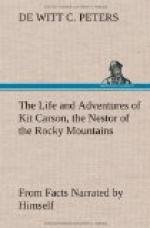Finally, the command reached Fort Massachusetts, where, in ease and plenty, the half starved, half frozen, half used-up men soon forgot all their troubles and privations. A few weeks spent at the fort, acted like a magic charm in recruiting the men and the remaining animals, when they were once more in a fit condition, and, again eager to go on the war path, anxiously desiring to surpass the splendid deeds of their first tramp.
At the permanent camp, which was made near Fort Massachusetts, the Mexican Volunteers, especially, enjoyed themselves hugely. From privations of various kinds, to which they had shown themselves to be well trained, and which consequently affected them but little, they were suddenly placed in a state of comparative comfort and even luxury rarely realized at their own homes. They had not much else to do beyond guarding their animals and attending to such other minor duties as were required by camp duties. Had not their hardy ponies required the rest that was now being given them, these troops would have been kept in more active service; but, as this could not be, they were allowed a respite, which they themselves turned into pleasure. Foot races and various athletic games were concocted and played by them, making the time pass merrily by. Their discipline and respect for their officers had reached a degree seldom, if ever, attained by volunteer soldiers, and which, in many respects, could be imitated with advantage by regular troops.
But the time soon arrived for the march to be resumed.
At a council held among the chief officers, it was decided that the best and surest course to be followed would be to divide the forces and send them out in quest of the Indians, as if they were separate commands. Thus it might happen that being caught between the two, as they were running from danger they would rush into it and receive chastisement sufficient to answer all purposes. Acting on this plan, Colonel St. Vrain, with most of the Volunteers, was ordered to proceed in one direction, while Colonel Fauntleroy, with the main division, started in another; while on his route, Colonel Fauntleroy traveled close in under the mountains, and kept his men as much concealed as possible, making most of his marches by night. He traveled through the Valley of San Luis up to its head.
The Valley of San Luis is about one hundred miles in length. Its greatest width is fifty miles. On either side, it is bounded by snow-capped mountains. The scenery of the valley is very prepossessing, being sure to enchant the eye throughout its entire length. In the south, the valley is continuous with prairie land, which extends down as far as the settlement of Rio Colorado. It is well watered by mountain streams and bears the appearance of being an excellent farming district; but, the probability is, that its climate is too cold for raising crops, and that its true value will be found chiefly to consist in using it for grazing purposes. From time to time, the Indians have reported that it contains gold mines, but there are no authentic proofs that this is a fact.




